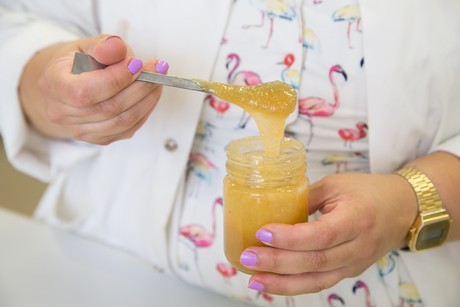Australia's antibacterial honey

Researchers have found that the nectar-derived chemical that gives New Zealand’s manuka honey its apparently unique antibacterial properties is also present in Australian varieties. Published in the journal PLOS ONE, their study provides hope for clinicians seeking treatment for antibiotic-resistant skin infections as well as chronic and acute wounds.
Honey has been used therapeutically for hundreds of years, with different varieties containing different medicinal properties depending on the flowers bees visit for nectar. As explained by Dr Nural Cokcetin from UTS’s ithree institute, “What makes manuka honey so special is the exceptionally high level of stable antibacterial activity that arises from a naturally occurring compound in the nectar of manuka flowers. It’s the ingredient we know acts against golden staph and other superbugs resistant to current antibiotics.”
The compound in question, methylglyoxal (MGO), has already been found to act against golden staph and other superbugs resistant to current antibiotics. As noted by Professor Liz Harry, director of the ithree institute and lead investigator on the project, “Honey not only kills bacteria on contact, but we have shown previously that bacteria don’t become resistant to honey.”
New Zealand is the world’s primary source of medicinal honey, but the country grows only one species of manuka (Leptospermum) tree, and its honeybee population is threatened by the parasitic varroa mite. Australia, meanwhile, is home to 83 of the 87 known Leptospermum species and is still free of the varroa mite. But just how powerful are our honey’s antibacterial properties?
In a collaboration which also involved the University of Sydney and the University of the Sunshine Coast, Professor Harry’s team studied more than 80 honey samples from NSW- and Queensland-flowering Leptospermum trees. Dr Cokcetin said, “Our study provides the proof for what we’ve long assumed — that … MGO is present in high levels in Australian manuka honeys.
“We’ve also shown that the activity of Australian manuka honeys has remained unchanged over seven years from harvest, which has huge implications for extending the shelf life of medicinal honey products.”
Dr Cokcetin said the study will “put Australian manuka honey on the international radar at a time when antibiotic resistance is recognised as a global crisis”, offering new opportunities for Australia’s 12,400 registered beekeepers and 200,000 commercial hives.
Retinal health linked to dementia risk, study shows
Researchers have discovered that the blood vessels at the back of the eye — called retinal...
Pancreatic cancer hijacks metabolism switch to help it spread
Pancreatic cancer hijacks a molecule known for regulating physiological processes, such as food...
Novel antibiotic activates 'suicide' mechanism in superbug
Researchers have discovered a new class of antibiotic that selectively targets Neisseria...




